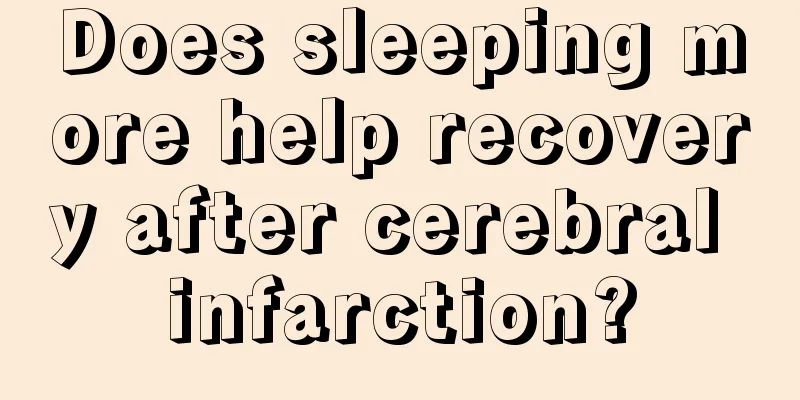Does sleeping more help recovery after cerebral infarction?

|
In recent years, many patients have suffered more troubles. In fact, patients with cerebral infarction usually show impaired consciousness function and mental atrophy. They always want to sleep and feel drowsy all day long. Some people may have been very lively before, but recently they have become silent and taciturn, their movements are relatively slow, but their language is more irritable. Although sleeping more is beneficial to recovery for patients with cerebral infarction, they should also pay attention to these exercises in their lives. What are the treatment methods for cerebral infarction recovery? 1. Daily life training: After a cerebral infarction, many previous living habits are disrupted. In addition to training the affected limb as early and formally as possible, attention should also be paid to developing the potential of the healthy limb. Patients with right-sided hemiplegia who are accustomed to using their right hand (right-handed) should train their left hand to do things. Clothes should be made loose and soft, and special styles can be sewn according to special needs. For example, a zipper can be installed on the sleeve of the affected limb to measure blood pressure when seeing a doctor. When dressing, put on the paralyzed side first and then the healthy side; when undressing, take off the healthy side first and then the affected side. 2. Use medication scientifically and accurately to prevent recurrence of cerebral infarction: Cerebral infarction is a chronic cerebrovascular accident with a high recurrence rate and is irreversible. After discharge, the patient still needs to take medication regularly as prescribed by the doctor, control underlying diseases of arteriosclerosis such as hypertension, hyperlipidemia, and diabetes, and go to the hospital for regular check-ups. Commonly used effective drugs for the treatment of cerebral infarction include antiplatelet aggregation drugs, such as aspirin; brain protection nutritional drugs, and qi-invigorating, blood-activating, orifice-opening and analgesic drugs. 3. Start rehabilitation treatment early and actively: As mentioned earlier, cerebral infarction will leave many sequelae, such as monoplegia, hemiplegia, aphasia, etc. The effect of drugs on these sequelae is very limited. Through active and regular rehabilitation treatment, most patients can take care of themselves, and some can even return to work. If possible, it is best to go to a regular rehabilitation hospital for systematic rehabilitation. If you cannot go to a rehabilitation hospital for treatment for various reasons, you can buy some relevant books and videotapes and do it yourself at home. Rehabilitation should be started as early as possible. The best time for recovery is within 3 to 6 months after the illness. After half a year, recovery will be more difficult due to muscle atrophy and joint contracture, but it will also be of some help. 4. Face reality and adjust your emotions: As the saying goes: "Illness comes like a mountain falling, and goes away like a thread being pulled." This statement is more appropriate for patients with cerebrovascular diseases. Faced with the fait accompli, one should adjust one's mood and actively pursue rehabilitation in order to return to society as soon as possible. Patients with severe mood disorders can seek help from a doctor and use antidepressants, such as Prozac, which have a good effect on depression and anxiety after cerebrovascular disease. 5. Functional recovery care for sequelae: (1) Language Disadvantages Patients with language disorders tend to be anxious and distressed. Medical staff should have more contact with patients, understand their pain, keep them in a good mood and eliminate their tension. Patients must be induced and encouraged to speak as early as possible, and their pronunciation must be corrected patiently, from simple to complex, such as "e", "ah", "ge", etc., with repeated practice and perseverance. It is also combined with acupuncture of the Yamen, Tongli, Lianquan and other acupoints, which is beneficial to promote the improvement and recovery of language function. (2) Limb dysfunction: During the acute phase of care, care should be taken to place the paralyzed limb in a functional position to prevent limb contracture and deformity. Supine and lateral positions are often used. When the patient's condition is stable, guide and assist him to perform functional exercises, starting with simple flexion and extension. The exercises should be full, reasonable and moderate to avoid damaging the muscles and joints. The exercises should be done 2 to 4 times a day, each time for 5 to 30 minutes. And cooperate with drug treatment, massage the affected limb, acupuncture Quchi, Hegu, Zusanli, etc. Ask the patient to soak the affected limb frequently in hot water to promote blood circulation. |
>>: What are the symptoms of cerebral infarction
Recommend
How to identify bed bugs in bedding
Bed bugs refer to a type of pest that breeds in b...
The jaw bone is crooked. Which department is good?
Everyone's chin is different from others. The...
How to check liver cancer? 3 methods of ultrasound examination for liver cancer
As the number of patients with liver diseases inc...
Can I drink cold drinks when I have a fever?
Many people like to drink cold drinks, especially...
Sigmoid colon wall thickening_Sigmoid colon wall thickening
Many people like to eat pig intestines. No matter...
How to deal with nasopharyngeal cancer with bloodshot nose
How to treat nasopharyngeal cancer? Cancer is a w...
What are the TCM treatments for fibroids?
What are the TCM treatments for fibroids? Fibroid...
Can I drink honey after removing a mole?
For friends who have had their moles removed, the...
Hematuria is the main symptom of bladder cancer
Urinary tract cancer mainly forms in three places...
Talk about the overview of fibroid disease
Fibroids are a very common disease in daily life....
Does pituitary tumor still need treatment?
Do pituitary tumors still need treatment? Some pa...
What should I pay attention to after laryngeal cancer surgery
Reasonable diet. Thirdly, long-term regular follo...
What are the symptoms of malignant lymphoma and how to treat it
Lymphoma is a very difficult cancer to treat, and...
The efficiency of total laryngectomy in treating laryngeal cancer has been much higher
The efficiency of total laryngectomy in treating ...
What material is good for a spatula
There are many materials for spatulas, including ...









